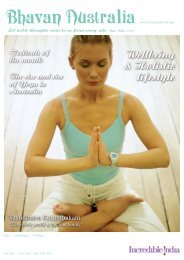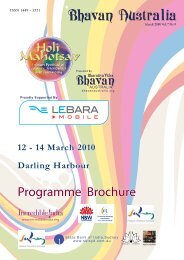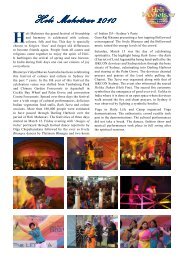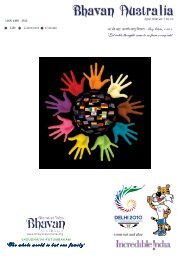World Peace - Bharatiya Vidya Bhavan Australia
World Peace - Bharatiya Vidya Bhavan Australia
World Peace - Bharatiya Vidya Bhavan Australia
You also want an ePaper? Increase the reach of your titles
YUMPU automatically turns print PDFs into web optimized ePapers that Google loves.
multiplying creation. They are met by Narada who says<br />
there is a nation which is in the sole control of a ruler.<br />
There is an opening in the country from which there<br />
can be no getting out. There is a lady there who takes<br />
many forms and a male who runs after her. There is a<br />
river in that country which flows same time from one<br />
and the same point towards opposite directions.<br />
There are 25 shore huts. One hears sweet and attractively<br />
fictional and distinct music also from the<br />
swans. There is a wheel ever spinning fast which has<br />
edges as sharp as a lancet. Without understanding<br />
this, what is the point in languishing for creation?<br />
The puzzle when resolved is simply this: There is only<br />
one master for the world, namely, God. The hole in<br />
the world is death, out of which none can be extricated.<br />
The lady referred to is the play of five senses<br />
to which man is a prey. The river flowing in opposite<br />
directions is the river of life which leads to morality<br />
as well as immortality, according to the conduct of<br />
the individual concerned.<br />
The shore huts are the 25 tattvas. The music of the<br />
swan is the attractive Vedic texts of Karma marga<br />
promising this, that or the other for doing this or the<br />
other yajna. The wheel is Kala Chakra. Knowing the<br />
limitations of the world in this manner, one should<br />
conduct oneself with its master namely God. All other<br />
efforts will be futile.<br />
No wonder, on hearing these words of wisdom, the<br />
Haryawas betook themselves to the quest of the Lord.<br />
Vyasa is the author of Brahma Sutras, which are aphorisms<br />
proclaiming Vedantic truths. It is only natural that,<br />
in his Puranic works also, he took care to highlight the<br />
need for discriminating between material welfare and<br />
spiritual well-being. The thread of expansion of the Infinite<br />
through finite creations is displayed as the means<br />
to understanding the real roots of happiness. That does<br />
not consist in running away from the origin, but running<br />
towards it. Such running towards the origin calls for a<br />
Constant remembrance of God. Says Vyasa through<br />
Suka: Until you are able to discern God in all the infinite<br />
creations of his around you, you will have to do<br />
Sthoola Dharma of God as constituting and in-<br />
42 | <strong>Bhavan</strong> <strong>Australia</strong> | August 2012<br />
The state of the<br />
country is the<br />
direct outcome of<br />
the condition of its<br />
ruler. There can be<br />
no extenuating<br />
circumstance for<br />
the ruler for<br />
deviating from the<br />
dharmic path.<br />
dwelling in all such creation.<br />
Thus the story part of the Puranas has a validity<br />
which is ingrained in the Paramarthika texts of Vedantic<br />
literature. Even while describing the details of the<br />
Hindu pantheon, the principle of unity as consisting<br />
in the oneness of God is not sacrificed. Brahma<br />
comes out of the navel of Vishnu. Rudra comes out of<br />
the anger of Brahma. Everything comes out of the primordial<br />
waters indwelt by Narayana.<br />
Everything collapses in the wrath of Siva. The fundamental<br />
force operating underneath all creation is Sakti.<br />
Being feminine, it is made into a goddess to whom the<br />
other gods are vassals. But time and again Vyasa clarifies<br />
the symbolism behind all such description, whether<br />
it is the Krodhaa-karaankusa of the Devi, the Kala Carka<br />
of Vishnu or the Chandrahasa or thunderbolt of Siva.<br />
Having been composed for less evolved souls like<br />
ourselves, the Puranas present the essence of the<br />
formless infinite through a diversified spectrum of<br />
forms each of which has a bunch of qualities which<br />
will appeal to the select core of its special worshipers.<br />
These forms are relatively unreal but they<br />
help in leading the savant to the real. The fulfilment of<br />
the prayer “Lead me from the unreal to the real” becomes<br />
easier by cultivating such personal Gods.<br />
As regards the political code of the Puranas, the emphasis<br />
is on democratic monarchy where, if the king<br />
transgresses the guidelines of councillors representing<br />
public opinion, he loses the right to govern and<br />
can stay only as an ornamental head.<br />
The Hindu concept is that he who is devoid of Vishnu<br />
Amsa, cannot be born to rule. Since royalty is a birth<br />
right, the annihilation of the king is taboo. Most of the<br />
Puranas are one in reiterating the sentiment contained<br />
in the familiar verse of the Mahabharata. The<br />
state of the country is the direct outcome of the condition<br />
of its ruler. There can be no extenuating circumstance<br />
for the ruler for deviating from the<br />
dharmic path. Picture credit: Sudin M. Pai Kane<br />
S.N. Sriramadesikan<br />
Source: <strong>Bhavan</strong>’s Journal, January 31, 2012









